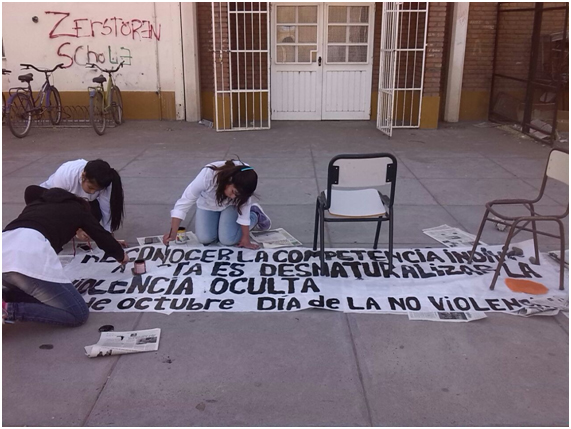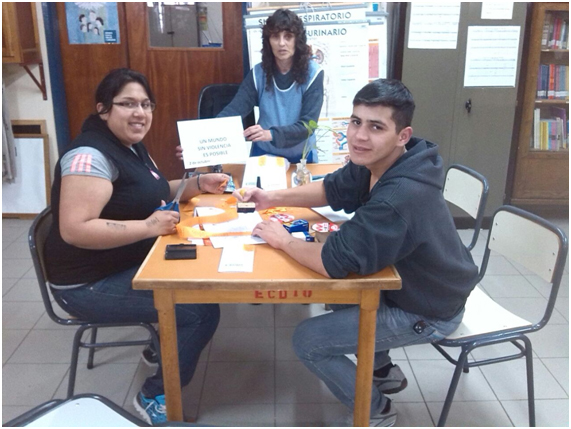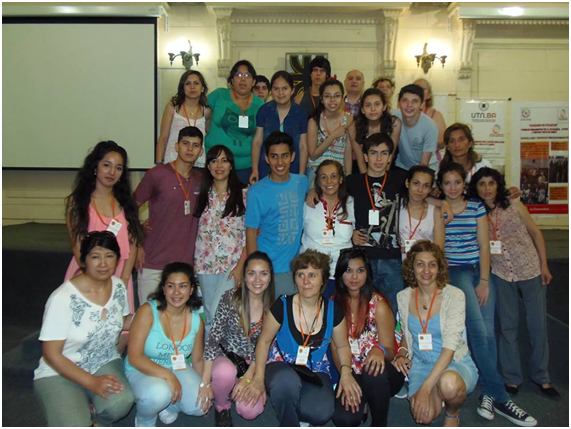Villa Regina, a city of 33,000 in the Patagonian province of Rio Negro in southern Argentina, began the process of becoming a “nonviolent city” four years ago.
Today the city has two training centres (Comahue National University, and State Secondary School No. 70) and an organizing team of 32 volunteers trained in three-level change (most of them young people), as well as the support of the Governor, the Mayor and City Council, the provincial and local school systems, and the city and nonprofit media. In collaboration with other participants, team members have begun to apply the three-level change method in three nearby cities, training people from different institutions in participation and solidarity, and have been giving their own testimony about overcoming personal violence.
We interviewed Juan Jose Pescio, one of the members of the network of nonviolent city builders, about the steps necessary for achieving these results and about the network.
Pressenza: Is this process of change in Villa Regina part of a larger project?
Yes. This process is currently developing in dozens of cities in several different American and European countries. Launched 12 years ago by a group of Universal Humanist activists, this activity currently involves hundreds of people and reaches many more. The construction process being applied in different cities in the network is similar (though not identical), but what they all have in common is the guidance of a training manual called Creating a Culture of Nonviolence, which can be downloaded at www.consejosnoviolencia.org.
Pressenza: When did this construction process start in Villa Regina?
It started in 2011, after the distance training organised through the Buenos Aires National Technological University. At the end of that training, the principal of State Secondary School No. 70 proposed applying the “Nonviolent Cities” proposal in his city. He began with the 700 students and 137 educators in his school. Since then there’s been a significant increase in participation, with members getting in touch with their deepest aspirations for living in a caring environment.
Pressenza: What were the first steps they took?
Professor Néstor Zaninelli began by democratizing his institution, opening up participation and dialog. Over the first couple of years he trained the first students and teachers who expressed interest in the proposal, and built a Community of Active Nonviolence using the three-level change method, with emphasis on overcoming internal violence and violence in relationships
At the same time he made an agreement with the Comahue National University, which has since become an “Active Nonviolence Training Center” where the course is taught every two weeks for eight consecutive months, with meetings involving 5-6 hours of intensive work.
Pressenza: What does the training consist of?
The training is eminently practical, with a theoretical framework that gives a new meaning to violence, the causes of violence, and the way to overcome it. For example, there are personal exercises for getting to know yourself and overcoming the violence inside you. Another aspect is the formation of groups that begin to organize, bringing these ideas and practices to others in the institution and to their own families and communities.
This is not just about overcoming violent behavior in daily life. It’s about broadening our point of view and seeing inequality of opportunity as a form of economic violence on the social level, authoritarianism as a form of violence on the institutional level, and resentment and lack of meaning as forms of violence on the personal level, all generated by the self-centered possessiveness of our global culture. We look at the causes of violence on each of these three levels, and see how they reinforce each other in a negative spiral, a kind of vicious circle. This phenomenon of feedback on the three levels – personal, institutional, and social – can also be transformed into a positive spiral, a “virtuous circle,” if we begin to overcome the causes of violence on each level.
Pressenza: Does the university offer a certificate at the end of the course?
Yes. The pre-requisite for receiving the certificate is that after finishing the course for “Community of Active Nonviolence Trainer,” a participant applies the process in another institution, reproducing the course and beginning to build a Community of Active Nonviolence there. Above all, students are trained in applying the techniques for overcoming internal violence and violent behavior with others in the family, work, and study environments (see Relaxation Course, Self-Liberation by Luis Ammann; Guided Experiences by Silo, etc.).
Pressenza: So after finishing the course the participants keep applying what they’ve learned in their institutions and communities?
Yes, in fact, the participants from last year’s course have kept up the constructive activities begun in the course, working in Villa Regina and in other nearby cities (Roca and Allen) in Rio Negro Province. They are also beginning the process in Cipolletti.
For example, several graduates of last year’s course belong to the 32-member city organizing team in Villa Regina. The young people in the organizing team are the ones who gave the courses this year at the university. They did this in two groups of 20, with an age range from 15-65, including secondary school teachers, university students, professionals, neighbors, etc. Other team members worked on deepening the three-level change process in different institutions.
This team has a horizontal relationship with the other teams in the nonviolent cities network. Their decisions are autonomous, since the network is a decentralized organization that encourages free communication among its members. There have been relationships of collaboration and interchange among them for several years now. These elements give internal cohesion to the network and constitute a concrete learning environment for collaborative relationships. Working in teams for solidarity on one hand, and a network that connects the teams in united action and reflection on the other, are what allows transformation on a much greater scale and in less time than what might be achieved through individual acts of solidarity.
This horizontal way of working allows us to build what we call “caring and nonviolent human environments.” Participants in these environments share a common ideal, defined as “the world we want,” and a common procedure for reaching it. This concept of “world” can be seen on different levels, from one’s immediate personal surroundings, to the city, province or state, country, continent, or planet.
Pressenza: Can you talk about some evidence of progress in the educational institution where the process began?
We can mention the following:
a- The 4th and 5th year student team at School 70 trains the 1st and 2nd year students in their free time, with a beginning course they have adapted to this age with a game-based format.
b- The more advanced students have been invited by other schools to reproduce what they are doing (since it is a small city, these “demonstration effects” travel by word of mouth).
c- Dialog is taking place in the school, and the communication between the different levels has improved. According to the educational authorities, who consider this school a model to emulate, there’s been a marked decrease in violence in school and outside school.
d- Many parents have expressed their gratitude for the changes they are seeing in their children, and this year they’ve been asking to participate in the nonviolent family trainings that have been taking place since last year. (The nonviolent family training can be found in the manual Creating a Culture of Nonviolence.)
- e) More than 20 young people who attended the Fourth International Nonviolent Cities Gathering at the Buenos Aires National Technological University testified about overcoming their own internal violence and building collaborative relationships as participants in this process.
Pressenza: What signs of progress can you see toward the building of a nonviolent city?
- Many 5th year Secondary School graduates who have been trained and have experience in three-level change have enrolled in different universities this year with the intention of continuing to reproduce the proposal.
- The organizing team has acted as a mediator in situations of extreme violence in the community, protecting the victims and finding help for them with the appropriate organizations, accompanying them and including them throughout the entire process.
- Through a local radio program, participants have shared testimony of their experiences and have trained listeners who requested it at a distance via email.
- Two active 18-year-old team members were invited to represent the Communities of Active Nonviolence at the Mercosur Youth Parliament Conference that took place in November 2014 in Argentina.
- The National Department of Education, through its National Socio-Educational Program, has invited the Communities of Active Nonviolence to train 50 students (middle and secondary school) in 2015 to train others in nonviolence as a universal value.
Pressenza: What kind of acceptance is the proposal finding at the official level?
- The Deliberating Council of Villa Regina has again declared Three-Level Change to be “of interest to the city” for the fourth year running.
- One of the provincial legislators introduced the proposal to the Rio Negro Legislature to have it declared of educational and community interest in the province.
- The governor of Rio Negro Province earmarked funds for 31 delegates (mostly youth) to travel to Buenos Aires (1000 km away) to the Fourth International Nonviolent Cities Gathering, where they testified about the changes they have made toward nonviolence and about their commitment to a caring and nonviolent culture.
- The mayor of Villa Regina provided the funds for lodging and travel allowances for the same delegation.
Pressenza: What are the next steps for the network?
We are continuing to deepen the internal and external changes we’ve made, holding retreats and personal work meetings, bringing the proposal to new places, generating new translations of the manual and training new trainers. A new stage of complementation has begun among the teams in the network. For example, a few days ago there was a meeting among representatives from three network groups near La Reja Park to evaluate the last year and plan the next.
To reach new countries and cities quickly we will continue with the two-week Nonviolent Cities distance trainings, with which we trained interested people in 9 countries and 6 Argentine provinces in November 2014.
By clicking on the following link you can see the presentation of this course on the web of the educational institution it was given through.
Pressenza: How else can we see how this constructive process is evolving in Villa Regina?
The information offered in this article is intended to communicate the level of development over four years in one city, and to show at the same time how the network is being organized and growing. To give an idea of the progressive changes in this particular place by comparing the current situation with previous moments, we have an interview from two years ago that a local television channel did with people from School No. 70, the institution that initiated the construction of a Nonviolent Villa Regina.
Video:
www.youtube.com/watch?v=102ZoU37Cyo
(Translated from Spanish original)












